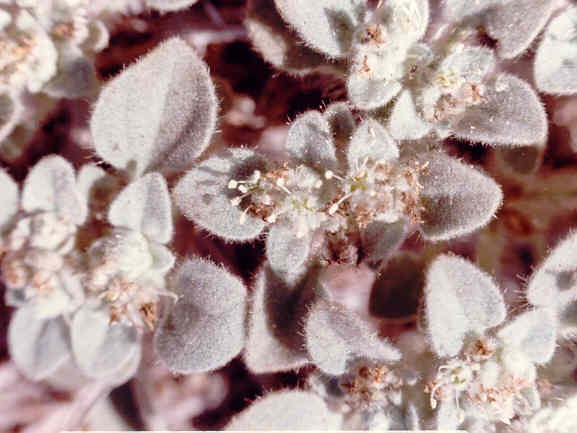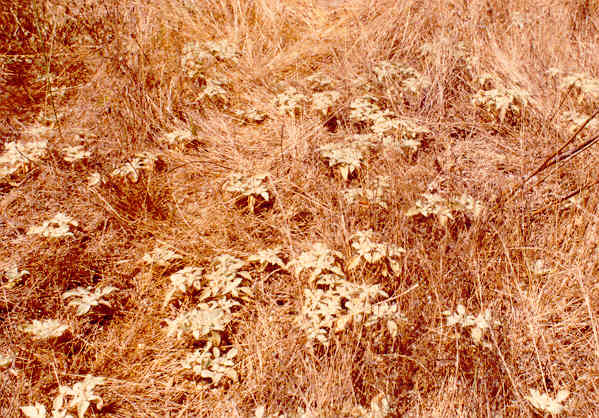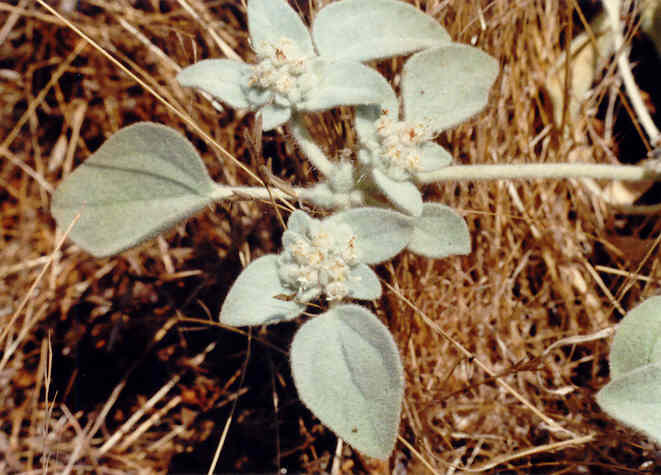
 |
Eremocarpus setigerus (Hook.) Benth.Euphorbiaceae (Spurge Family)NativeTurkey MulleinDove Weed |
October Photo
Plant Characteristics:
Low, broad, gray, heavy-scented annual, 3-20 cm. high with alternate, entire, 3
nerved leaves, ovate to suborbicular, 1-5 cm. long, on petioles as long,
stellate-pubescent and with stinging longer hairs; staminate fls. pedicelled;
calyx ca. 2 mm. long; caps. 4 mm. long; seed dark, +/- variegated, 3-4 mm. long;
pistillate fls. 1-3 in lower axils, without a calyx or corolla; pistil
pubescent; ovary with 4 or 5 small glands at base.
Habitat:
Common in dry open places, mostly below 2500 ft.; Coastal Sage Scrub, V.
Grassland, Oak Wd.; cismontane especially away from immediate coast, occasional
at desert edges; to Wash. May-Oct.
Name:
Greek, eremos, solitary, and karpos,
fr. Setigerus, bearing
bristles, referring to the hairy stems, sepals, ovaries and style.
(Dale 107).
General:
Very common in the study area.
Most growth occurs during the dry season.
Photographed specimens from Santa Heights and the area west of the Delhi
Ditch. (my comments). California Indians used the heavy-scented herbage to
stupefy fish in small streams in order that they might be caught by hand.
This is where the Spanish name Yerba del Pescado came from.
Turkeys and turtle doves seek the seeds. (Dale 107).
Hairs on the surface of the leaves lead to the production of hairballs in
the stomachs of grazing animals which causes discomfort and cessation of
feeding. (Robbins et al. 282.)
Medicinal uses of the plant include fevers, chills,
internal pain and asthma. (Bauer 158).
The herbage
toxic to livestock, especially in hay. (Hickman,
Ed. 573). The
fresh plant vinegar makes an excellent counterirritant for chest and
inter-costal muscle soreness caused by physical exertion or heavy coughing.
It helps the pain of dry-membrane pneumonitis and pleurisy, as well as
mild emphysema and the "smog lungs" that some children and adults get
from the humid air pollution in some of the Southwest. The fresh plant tincture applied to the forehead and scalp
can help some sick headaches and hangovers.
The Pomo and Kawaiitsu of California used it as a well-strained tea
(don't swallow those itchy hairs) for stress palpitations, hot and cold shaking
chills from viral fevers, and for bleeding diarrhea.
A tea of the dried plant added to bath water will stimulate sweating in
early, dry fevers, especially in children.
Drinking the tea for chills seems to work better when it is boiled as a
decoction, evaporating off some of the volatile oils and leaving the
nonevaporative muscle-relaxant constituents in the tea. (Moore, Medicinal Plants of the Desert and Canyon West 125).
As the leaves contain a narcotic poison, Indians used the
foliage to poison their arrow points. (Sweet
44). One species in the genus.
(Munz, Flora So. Calif. 409).
Text Ref:
Collins 52; Hickman Ed. 573; Munz, Calif.
Flora 162; Munz, Flora So. Calif.
409; Roberts 22.
Photo Ref:
July 3 83 # 11,12; June 1 86 # 17.
Identity: by R. De Ruff,
confirmed by F. Roberts.
First Found: July 1983.
Computer Ref: Plant Data 91.
Have plant specimen.
Last edit 12/18/04.
 |
 |
June
Photo
June Photo